 
|
AIR AND
HEALTH
Sources of air pollution
|
This section summarises the main sources of
air pollution today. The contribution of each source to local
pollution will vary according to the type and number of local
industrial processes, density and age of road transport and local
weather conditions. Other pamphlets in this series will describe
the problems in more detail and offer solutions for improvement.
 Industrial
Sources
Industrial
Sources
The figures used describing the respective
production of pollutants by each sector are taken
from "Air
pollution in Europe" (EEA, 1997). Data relates to the year 1994 and to 28 countries in
Europe(3).
 Power
Generation
Power
Generation

Siting fossil fuel power stations in mainly
rural areas and distributing the pollution produced more evenly
via tall chimneys has resulted in improved urban air quality,
though they still remain a major source of pollution, mainly
sulphur dioxide and nitrogen oxides.
Better dispersion of pollutants emitted by
tall chimneys leads to better dilution in the air and thus lower
local concentrations of pollutants. This has however led to
pollution being dispersed more widely and to transboundary air
pollution.
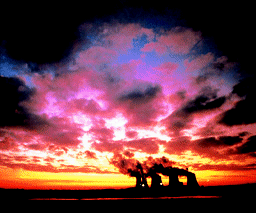 Stricter operating
practices and the use of modern abatement techniques have
resulted in a considerable reduction in the amount of pollutants
emitted from power stations; high concentrations do however occur
in many eastern European countries, particularly from older power
stations and from the use of high sulphur lignite or brown coal.
Exceptional concentrations may also occur on a very local basis
if a plume of smoke from, for example, an industrial chimney
falls to the ground due to local atmospheric conditions.
Stricter operating
practices and the use of modern abatement techniques have
resulted in a considerable reduction in the amount of pollutants
emitted from power stations; high concentrations do however occur
in many eastern European countries, particularly from older power
stations and from the use of high sulphur lignite or brown coal.
Exceptional concentrations may also occur on a very local basis
if a plume of smoke from, for example, an industrial chimney
falls to the ground due to local atmospheric conditions.
The countries of the European Union and
those which are a party to the UNECE Convention on the Long Range
Transport of Air Pollution, Second Sulphur Protocol, are
committed to major reductions in sulphur dioxide emissions. Power
generation is, however, likely to remain an important source of
pollution for some time to come, particularly as some countries
are reconsidering their programmes of nuclear power generation.
 Other
Industry and waste disposal
Other
Industry and waste disposal
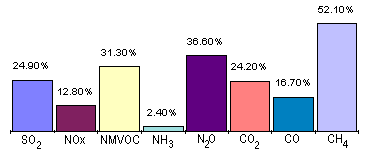
Although fossil fuel power plants are the
major source of industrial air pollution in many countries, all
industry and many businesses, large and small, can be significant
local sources of a wide range of air pollutants. The use of both
regulatory and planning controls will help to minimise their
effect on local air quality.
All waste has the potential to affect the
environment adversely by contaminating the air, soil or water.
Poorly managed waste disposal sites (landfill or incineration)
can also pose a danger to public health, through all these
routes.
 Landfill and
incineration are the two most common methods of waste disposal.
If not properly managed landfill sites can cause a number of
problems; these include the production of potentially explosive
levels of methane gas (65%), dangerous levels of carbon dioxide
(35%), plus trace concentrations of a range of organic gases and
vapours. Landfill sites also have the potential to cause major
odour when badly managed.
Landfill and
incineration are the two most common methods of waste disposal.
If not properly managed landfill sites can cause a number of
problems; these include the production of potentially explosive
levels of methane gas (65%), dangerous levels of carbon dioxide
(35%), plus trace concentrations of a range of organic gases and
vapours. Landfill sites also have the potential to cause major
odour when badly managed.
Uncontrolled or poorly managed burning of
waste (incineration) can result in the production of poisonous
chemicals such as hydrochloric acid, dioxins, furans and heavy
metals. Hydrochloric acid contributes locally to acid rain and is
given off by the burning of plastics. If organic matter and
plastics are burnt at low temperatures, dioxins and furans may be
emitted. Modern, properly operated incinerators produce fumes
which respect the strictest existing legislation.
 Road
Transport
Road
Transport

Air pollution from motor vehicles has, in
many countries, replaced coal smoke as the major cause for
concern; and the continuing growth in vehicle use means that
efforts to reduce emissions from individual vehicles are in
danger of being overtaken by increases in the volume of traffic.
In much of eastern Europe the continued use of rather old cars,
which are unable to meet modern pollution control requirements,
means that efforts to control pollution from this source are
going to be increasingly difficult.
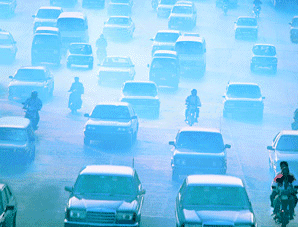 The air pollutants produced as a result of the use
of motor vehicles present a two-stage problem: primary and
secondary pollutants. Primary pollutants produced by
petrol-powered vehicles include carbon monoxide, nitric oxide,
benzene, particulate matter and lead. Much of the lead emitted by
vehicles burning leaded petrol emerges as particles. Diesel
engines burn fuel in excess of air and so produce little carbon
monoxide but, instead large quantities of carbon dioxide, (see
table). Secondary pollutants produced as a result of the use of
petrol-engined vehicles include nitrogen dioxide and ozone.
The air pollutants produced as a result of the use
of motor vehicles present a two-stage problem: primary and
secondary pollutants. Primary pollutants produced by
petrol-powered vehicles include carbon monoxide, nitric oxide,
benzene, particulate matter and lead. Much of the lead emitted by
vehicles burning leaded petrol emerges as particles. Diesel
engines burn fuel in excess of air and so produce little carbon
monoxide but, instead large quantities of carbon dioxide, (see
table). Secondary pollutants produced as a result of the use of
petrol-engined vehicles include nitrogen dioxide and ozone.
| Measures for
inclusion in a Local Transport Strategy |
- adequate and
affordable public transport;
- provision of safe
cycling and pedestrian routes;
- regular emissions
testing of private and public transport vehicles;
- encouraging local
business to use car pooling or car sharing
schemes;
- encouraging less use
of motor cars during weather conditions likely to
lead to an episode of pollution.
- encouraging better
fuel quality
- better planning of
the built environment aimed at reduced mobility
and improved access to shops, jobs, etc.
|
In those countries which have required the
removal of lead from petrol, concentrations of lead in air from
this source have been reduced to a level at which they are no
longer a problem. Lead-free petrol has also made the use of
"catalytic converters" possible. Catalysts
substantially reduce emissions of hydrocarbons, NOx and carbon
monoxide; they do however increase emissions of carbon dioxide,
an important greenhouse gas, and have no effect on emissions of
particles. Since 1993 all new petrol-engined cars in the European
Union have to be fitted with catalytic converters.
Prior to the introduction of cars fitted
with catalytic converters, diesel-powered vehicles were
considered "cleaner" than petrol-powered cars. EU
legislation requires that they meet the same limits for
hydrocarbons, NOx and CO as petrol-driven cars. Diesel fuel
contains no lead but is a considerable source of particulate
matter, PAHs and SO2. The introduction of lower sulphur diesel
fuels throughout the EU will reduce emissions from this source
(see table).
In many countries, there has been a policy
of progressively tightening emission standards for cars and
lorries in line with EU directives and UNECE standards. However,
much more will need to be done to ensure that reductions in
vehicle emissions are not offset by the rapid increase in vehicle
ownership and use.
This is an area in which action by local
authorities can make a significant impact on local air quality
and indeed benefit the local community in terms both of their
health and of local amenities. Each local authority will need to
consider how it can best tackle the problem, bearing in mind the
resources available and other priorities for cutting pollution.
Improved public transport, "park and ride" schemes,
traffic restrictions, planning guidelines and encouragement to
cycle and walk are some of the measures that local authorities
can take. Requiring vehicle owners (and businesses) to maintain
their vehicles regularly will ensure that fuel is burnt
efficiently and economically, and will therefore be less
polluting; and fuel consumption is more efficient at lower speeds
(60 - 90 km/h).
Average emission factors of different fuels
| Emission factor |
Environmental third class diesel |
Environmental first class diesel |
Ethanol |
| Regulated pollutants: |
|
|
|
| Carbon monoxide, g/km |
3.3 |
1.9 |
0.25 |
| Hydrocarbons, g/km
|
1.3 |
0.72 |
0.13 |
| NOX, g/km |
13.2 |
9.7 |
9.5 |
| Particulates, mg/km
|
510 |
200 |
53 |
| |
|
|
|
| Unregulated pollutants: |
|
|
|
| Carbon dioxide, kg/km |
1.2 |
1.1 |
1.2 |
| Formaldehyde, mg/km
|
70 |
29 |
18 |
| Acetaldehyde, mg/km
|
19 |
20 |
72 |
| Sum, particle-bound PAH |
|
|
|
| (> 3 aromatic rings) mg/km |
220 |
39 |
6.0 |
| All
emission factors from emission tests performed using the
Braunschweig transient bus cycle. (From: Westerholm,
R. and Wijk, A., "Vehicle exhausts", Swedish Environmental
Protection Agency, Report 4528, Stockholm, 1996). |
 Domestic
Sources
Domestic
Sources
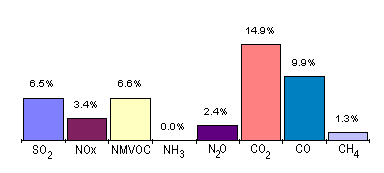
Before about 1960, the domestic use of coal
was the major source of particles. Concentrations of airborne
particles in many European cities frequently exceeded 1000 µg/m3
and annual average concentrations of several hundred µg/m3 were
commonplace. Today, annual average concentrations in most
European cities have
fallen to less than 30 µg/m3. In
eastern Europe much higher concentrations still occur as, to a
lesser extent, they do in southern European cities such as
Athens. Brown coal (lignite) is a key source of particles in many
parts of eastern Europe.
Coal varies in composition and calorific
value from mine to mine. Lignite is probably the poorest quality
in terms of calorific value and generates most pollutants when
used for domestic heating. Lignite contains 67% carbon (compared
with the 95% in anthracite) and burns easily, though
inefficiently, on an open fire. Special devices with carefully
controlled air supplies are needed to burn anthracite but
combustion is efficient and far less black smoke is produced.
Conversion of open fires to stoves suitable
for burning anthracite (or other smokeless fuel) should be
considered by any local authority where coal smoke is a problem.
The greater efficiency of controlled anthracite burning leads to
a saving in overall fuel costs, though an initial investment in
the necessary equipment must be made. Conversion to stoves which
ensure complete combustion are also a possibility as are district
heating schemes, using combined heat and power plants. The
greater use of renewable energy (wind, solar, tidal, wave, etc.)
and enhanced energy efficiency measures in homes and offices also
helps improve air quality.
Other important domestic sources of air
pollution are:
- gas and paraffin heaters, stoves and
cookers produce carbon monoxide. If ventilation is
inadequate or appliances poorly maintained, CO may
accumulate in dangerous concentrations. Nitrogen dioxide
is also generated and concentrations in kitchens will
usually exceed those outdoors when cookers are in use.
Ventilators can help reduce this pollution;
- bonfires, garden incinerators and
barbecues can be a significant local smoke and odour
nuisance. Burning garden waste produces smoke, especially
if it is damp and smouldering rather than dry and
blazing. The smoke contains CO and other noxious and
irritating compounds. Problems may be caused for
asthmatics, bronchitis sufferers or those with heart
conditions. Even if the immediate health risk is small,
bonfires add to the general background level of air
pollution.
 Agriculture
Agriculture
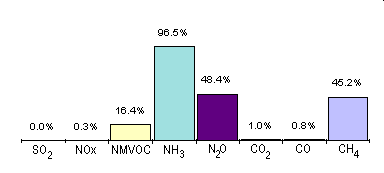
Agricultural practices can also be a
significant source of nuisance, contributing both to local levels
of air pollution and causing odour problems. The main sources of
pollution are the burning of agricultural waste, or of crops in
the field and large intensive livestock units. Depending on soil
type and fertilisation, the nitrogen in the dung and urine of
grazing cattle contributes 20-40% of nitrous oxide emissions from
agricultural land; methane is also emitted by cattle and other
ruminants; nitrous oxide and methane are of course both
greenhouse gases.
(3) The 28 countries are: the 15 countries
belonging to the EU plus Norway, Switzerland, Bulgaria, Poland,
Czech Republic, Romania, Hungary, Slvakia, Estonia, Lithuania,
Latvia, Slovenia and Malta.










Document Actions
Share with others